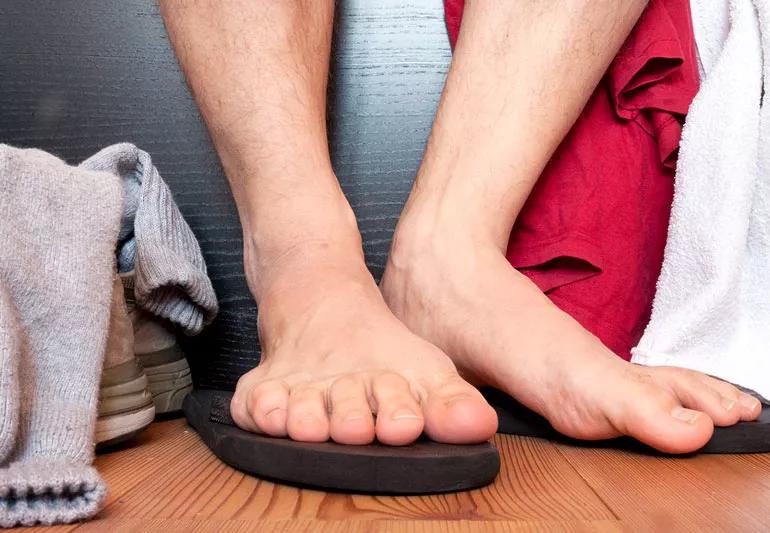Practicing good hygiene is your best defense

You probably don’t think about it, but a typical locker room is a massive breeding ground for germs. It’s naturally warm and moist and people come and go, often bringing colds, flu or other infections with them.
Advertisement
Cleveland Clinic is a non-profit academic medical center. Advertising on our site helps support our mission. We do not endorse non-Cleveland Clinic products or services. Policy
Yes, you visit the gym to improve your health, not catch a bug. But remember that even though fungus and bacteria may lurk, you can avoid them fairly easily with some simple bug-busting tips.
The two most common issues you’ll run into are athlete’s foot and staphylococcus aureus, says Robert Gray, MS, ATC.
Realizing they’re there is half the battle, but there’s still more you can do.
Athlete’s foot is caused by a dermatophyte, a type of fungus that thrives in warm, moist environments like bathrooms and showers. The most common way to get it is by coming into contact with surfaces contaminated with the fungus.
Symptoms of athlete’s foot include a scaly, itchy rash on the feet that can sting or burn and raw skin between the toes. You typically can treat it with an over-the-counter antifungal cream. If that’s ineffective, your physician can give you a prescription medication.
Aside from washing and drying your feet off after exercising — especially between the toes — your main defense against athlete’s foot is reducing your exposure.
“You want to minimize contact with locker room and bathroom floors,” Mr. Gray says. “Wear flip-flops — even in the shower. You can also protect your bare feet by standing on a clean towel while changing your clothes.”
Advertisement
And don’t forget to treat your shoes with an anti-fungal powder to avoid the potential for recurrence.
Staph infections are caused by staphylococcus aureus, a bacterium many people carry on their skin and about 30 percent carry in their noses. It’s typically harmless, but it can cause skin infections or become more serious when it moves into the bloodstream. It also can infect the heart or lungs.
“Staph can enter the body through a cut in the skin,” Mr. Gray says. “You see it most often in those who have an open wound or someone coming to the gym after surgery. But it can happen with any nick or cut in the skin.”
“If you have an ingrown hair or a nick around the cuticles or nails, you don’t always think a small area can create a problem. But infections will invade the weakest link and that is always a crack in the skin,” he adds.
A staph infection may show up as a red, painful, swollen boil or abscess on the skin. Your doctor typically can treat it with antibiotics or by draining it — and in some cases, both. However, some types — such as Methicillin-resistant Staphylococcus aureus (MRSA) — are antibiotic-resistant.
The best way to avoid a staph infection is to maintain good hygiene. As with avoiding athlete’s foot, minimize your contact with surfaces in the locker room when possible. Wear flip-flops or put a towel on the floor where you stand or on the bench where you sit. And, most importantly, if you have an open wound, cover it and keep it clean.
Hygiene really is the best deterrent to bacteria. Besides the tips mentioned earlier, always wash your hands before you touch your eyes or mouth.
Typically, the gym cleans its equipment regularly and many have policies asking patrons to clean after use. But you can clean the equipment yourself, too, and it’s best to be proactive. Also, you can bring your own towels or disinfectant wipes to use on things like hair dryers or lockers if you feel more comfortable.
If you have kids who use a school locker room, make sure they know to avoid contact with communal surfaces as much as possible. Encourage them to wash their hands well and to protect their bare feet if they change clothes or take a shower after their activities.
“In high school, kids play a game, take off their pads and jerseys, get on the bus and go back to school,” Mr. Gray says. “Rarely do kids shower anymore before they go home. So you need to make sure your kids get themselves cleaned off.”
They also may stuff their sweaty uniforms into a gym bag and not give them another thought. Washing their uniforms regularly and airing out shoes or cleats and any pads or braces they might wear can help protect against locker room germs as well.
Advertisement
The bottom line: Don’t let worries about germs keep you or your family away from the gym. Just make sure you take some common-sense steps to protect yourself from whatever may lurk in the locker room.
Advertisement
Learn more about our editorial process.
Advertisement

Try seated and standing exercises to help lengthen and strengthen the muscles that support your plantar fascia

Home remedies are unlikely to cure your contagious foot fungus — and they might even make it worse

Cramps can creep up if your shoes are too tight, you’re dehydrated or you have poor circulation

If soaking your feet, disinfecting your shoes and making lifestyle changes don’t do the job, it’s time to talk to a doctor

Genetics, hormones, medications and stress are just a few reasons your feet could be extra funky

Try stretching, massage, elevation and a supportive pair of shoes to help relieve foot aches and pains

Footwear that offers cushioning plus heel and arch support can help you relieve and manage symptoms

Except in certain medical scenarios, foot health experts rarely recommend foot soaks

Start having sex about 72 hours before ovulation, then at least every other day during your fertile window

Attachment theory suggests that your earliest relationships shape connections throughout your life

It isn’t a recognized mental health disorder, but research shows that problematic social media use can negatively affect your mental health, self-esteem and sleep